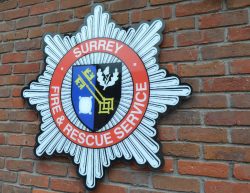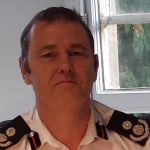 Abraham Lincoln
If given the truth, the people can be depended upon to meet any national crisis...
Abraham Lincoln
If given the truth, the people can be depended upon to meet any national crisis...
 Guildford news...
for Guildford people, brought to you by Guildford reporters - Guildford's own news service
Guildford news...
for Guildford people, brought to you by Guildford reporters - Guildford's own news service
Fire Chiefs Back Their Making Surrey Safer Plan But FBU Fighting Changes
Published on: 12 Sep, 2020
Updated on: 16 Sep, 2020

Surrey Fire and Rescue Service deputy chief fire officer Dan Quin demonstrating the “Dynamic Cover Tool” used for efficient deployment of resources. Photo: SCC.
By Julie Armstrong
local democracy reporter
Chiefs of Surrey Fire & Rescue Service have launched an all-out campaign to justify their operations revamp after national inspectors in December 2018 declared the service among the worst three of the UK’s 45 forces.
Fire executives deny their changes are cost-cutting, although their Phase One Included reducing two night crews to one at Guildford, Woking, Camberley, and Fordbridge stations in the face of stiff opposition from the Fire Brigades Union.
Next month, in Phase two of the Making Surrey Safer Plan, passed unanimously by the county council cabinet despite thousands of written objections, night crews are to be removed at Banstead, Painshill and Egham. The FBU says this will only increase public risk.
From October, these areas will rely on neighbouring stations between 3.6 and 5.3 miles away if a fire breaks out between 7pm and 7am.
More than 4,880 people have signed a new petition (petitions.surreycc.gov.uk/
A smoke alarm will alert you to a fire but it won’t come in and rescue you”
Chief fire officer Steve Owen-Hughes said: “To change the way we were operating was in the public interest, to shift resources from response that wasn’t quite right and HMICFRS [inspectors] had picked up on, and to do more protection and prevention which will save more lives. We are busier in the daytime than the night-time. Our Plan addresses that.”
But FBU secretary Graham Whitfield said: “The consequences could be catastrophic. What happens to the physically immobile? A smoke alarm is great and it’ll alert you to a fire but it won’t come in and rescue you.”
Before the changes, an SCC impact assessment found reduction in night cover may affect the time it takes to rescue people and said the most vulnerable would be the elderly and those with mobility and mental health issues.
There may also be an increased risk to young people, particularly male drivers aged 17 to 20, said to be seven times more likely of all male drivers to crash. Brake, the road safety charity, says the risk is 17 times higher between the hours of 2am and 5am.
Fire chiefs say they are trying to reduce the risks by creating 42.5 full-time posts in a community resilience team doing educational safe-and-well visits for people and businesses.
People were dying and they were dying before we could even get there”
Deputy chief fire officer Dan Quin said: “What we found was with any fatalities we’ve had, we wouldn’t have been able to make any difference even if we’d responded within our response times. We could not carry on like that.
“People were still dying and they were dying before we could even get there. Response is one area of our service, but you need to do more to prevent fires from happening in the first place.”
Mr Quin insists no staff have been cut. Rather, they have been moved to cover daytime instead of night, or from response to community
“No one has been or is being made redundant under this Plan,” he said. “It is about rebalancing resources.”
The HMICFRS inspectors had described the Making Surrey Safer Plan as a “comprehensive and evidence-based assessment of risk”. Brunel University has a second independent impact study.
But the FBU’s Mr Whitfield said: “How can you take away seven fire engines at night and say it’s not cuts? It’s primary school maths.
“Forty officers can’t train the 1.2 million people in Surrey. We’re not opposed to fire safety training in the community, but what about people who aren’t privy to that advice? The only people who are going to keep these people safe are the ones they’re taking away.”
He added: “They’re basing this on an algorithm, if it goes wrong they can blame the predictive data. Being reliant on that is doing the people of Surrey a disservice.”
If Phase Two goes ahead there’ll be an exodus … with no firefighters left in Surrey”
Mr Whitfield, who has worked for Surrey for 29 years, believes Phase Two, when 30 of Surrey’s 380 full-time front line firefighters transfer to fire prevention, will trigger a mass exodus from the service.
“It’s alienated the workforce,” he said. “They don’t feel valued. When they’re first on scene they want to know that the second appliance that turns up to support them is a local crew from a local station. They’re having to do 7am till 7pm instead of 9am till 6pm and if you have a young family you don’t see them.
“If this Phase Two goes ahead there will be another exodus in a few months and there’ll be no firefighters left in Surrey. They cannot train people as quickly as they’re leaving.”
An SCC spokesman said: “There is no evidence to say this will be the case. We are recruiting fulltime and on-call firefighters as well as community resilience personnel who will deliver essential prevention and protection activities to communities and businesses.”
Last year, the HMICFRS inspectorate praised the service for recruiting full-time staff. This year so far, 40 firefighters have left.
Roger Childs, assistant chief fire officer, said exit interviews showed this was down to retirement, ill health and moving to other services, often London for better pay. He said 26 had been taken on in 2020, though coronavirus had hampered recruitment. Last year, 52 left but 54 joined.
In other Phase One changes, cover at Walton and Haslemere stations, previously crewed only Monday to Friday, has been extended to seven days a week.
Before, Surrey response standard had been failing, the first engine arriving at critical incidents within 10 minutes only 75% of the time. After Phase One changes at the start of April, this has been met 94% of the time.
The fire chiefs say a minute has been shaved off their average response time, now seven minutes. Mr Quin said a fire engine is now en route within one minute 15 seconds in the day and two minutes at night.
This has been achieved through better technology, he added, allowing firefighters to get out the door more quickly and attendances to be logged automatically, combined with positioning fire engines on standby.
In 30 years, our response model hadn’t changed. It just wasn’t fit for modern life”
The FBU largely dismisses such improvements. Mr Whitfield said: “What’s happened since April? No one went to school, no one went to work, no traffic on the roads. It’s gone down for one reason, and that’s the pandemic.”
 Of the 2018 report, CFO Owen Hughes said: “That was a moment where we understood we had to change what we were doing. We couldn’t keep doing the same thing and just hope things would improve.
Of the 2018 report, CFO Owen Hughes said: “That was a moment where we understood we had to change what we were doing. We couldn’t keep doing the same thing and just hope things would improve.
“Our response model had not changed since the late Seventies and the watch system had been in place for more than 30 years. The world has changed in that 30 years and our response model hadn’t changed. It just wasn’t fit for modern life.
“This meant a fundamental review. At the time, there was already a plan which included closure of three fire stations, making 70 firefighter redundancies and smaller fire engines crewed by two firefighters, not our normal fire engines crewed with four. We also considered five years of incident data, risk data and national and local risk registers.
“Our remit was only and remains only to deliver a plan that serves the people of Surrey best. We were given no mandate to make cuts or do anything other than answer the shortfalls in the HMICFRS inspection and come up with a proper plan that would meet the needs of the people of Surrey and make them safer.
“So that’s what we did. It was in the public interest to change the way we were operating, to shift resources from response that wasn’t quite right and HMICFRS had picked up on, and to do more protection and prevention which will save more lives.
We are facing a fundamental culture change .. so that’s difficult for our firefighters”
“We must continue to do what is right for the people of Surrey and that’s what we’re going to do. We are faced with a fundamental culture change, having not done any big changes for the past 30 years so we understand that’s difficult for our firefighters.”
Kasey Beal, Assistant Chief Fire Officer, said, “The way we provided for and forecast crewing levels was decentralised, meaning dealt with locally by crews. This provided a huge opportunity for inconsistencies in crewing.
“So we are forming an Operations Management Centre (OMC), a dedicated group headed by a commander, who will assure our crewing levels and the forecasting of our front line appliance availability. The OMC and ongoing recruitment will help us reach our appliance coverage targets consistently.
“We’ve got a recruitment course in September which consists of 12 firefighters. We’ve also been able to bring staff from other services, including two watch commanders, two crew commanders and 10 firefighters from on-call.
“This year alone 12 additional personnel are being added to business safety, four more to community intelligence and a further 18 to community safety, where we protect the most vulnerable, including children and young people.
A key response standard is the first fire engine arriving within 10 minutes”
“Two of these new staff members are wildfire and partnership officers, which is obviously really important based on the common fires we’ve had recently at Chobham and Thursley. We want to manage fuel-loading and fire-breaks within the county, in partnership with the landowners, ahead of the next fire season.”
Mr Quin added: “The main driver here is about evidence-led decision-making. You can go to our website and see Brunel University’s report and equally HMICFRS’s view. When the HMICFRS visited the service last time, their view was the process we’d used to create the Making Surrey Safer Plan, the methodology, was sound and robust.
“All of the fire fatalities and serious injury incidents our community have experienced in the past two years, during the design of the Plan, would not have had any change even if we responded in 10 seconds. We could not carry on like that.
“A key response standard is the first fire engine arriving at critical incidents in 10 minutes. We are now performing about three minutes under that and also a minute better than last year.”
Responses to Fire Chiefs Back Their Making Surrey Safer Plan But FBU Fighting Changes
Leave a Comment Cancel replyPlease see our comments policy. All comments are moderated and may take time to appear.

"Found any?" - "Nope, it all looks green to me!" (See Opinion: The Future is Congested, the Future is Grey)
www.abbotshospital.org/news/">





Recent Articles
- Latest Evidence in Sara Sharif Trial
- Ash’s New Road Bridge Is Named – and November 23rd Is Opening Day
- Class A in Underwear Leads to Jail Sentence
- Historical Almshouse Charity Celebrates Guildford in Bloom Victory
- Notice: Shalford Renewable Showcase – November 16
- Firework Fiesta: Guildford Lions Club Announces Extra Attractions
- Come and Meet the Flower Fairies at Watts Gallery
- Updated: Royal Mail Public Counter in Woodbridge Meadows to Close, Says Staff Member
- Letter: New Developments Should Benefit Local People
- Open Letter to Jeremy Hunt, MP: Ash’s Healthcare Concerns


Recent Comments
- Paul Spooner on Ash’s New Road Bridge Is Named – and November 23rd Is Opening Day
- Harry Eve on Opinion: The Future is Congested, the Future is Grey
- Nigel Keane on Letter: New Developments Should Benefit Local People
- Nathan Cassidy on Updated: Royal Mail Public Counter in Woodbridge Meadows to Close, Says Staff Member
- T Saunders on Opinion: The Future is Congested, the Future is Grey
- Jim Allen on Updated: Royal Mail Public Counter in Woodbridge Meadows to Close, Says Staff Member
Search in Site
Media Gallery
Dragon Interview: Local Artist Leaves Her Mark At One of England’s Most Historic Buildings
January 21, 2023 / No Comment / Read MoreDragon Interview: Lib Dem Planning Chair: ‘Current Policy Doesn’t Work for Local People’
January 19, 2023 / No Comment / Read MoreA3 Tunnel in Guildford ‘Necessary’ for New Homes, Says Guildford’s MP
January 10, 2023 / No Comment / Read More‘Madness’ for London Road Scheme to Go Ahead Against ‘Huge Opposition’, Says SCC Leader
January 6, 2023 / No Comment / Read MoreCouncillor’s Son Starts Campaign for More Consultation on North Street Plan
December 30, 2022 / No Comment / Read MoreCounty Council Climbs Down Over London Road Works – Further ‘Engagement’ Period Announced
December 14, 2022 / No Comment / Read MoreDragon Interview: GBC Reaction to the Government’s Expected Decision to Relax Housing Targets
December 7, 2022 / No Comment / Read MoreHow Can Our Town Centre Businesses Recover? Watch the Shop Front Debate
May 18, 2020 / No Comment / Read More










John Perkins
September 13, 2020 at 10:53 am
So they are making the place safer by getting rid of those people whose job it is to make it safe.
Denise Hilton
September 17, 2020 at 8:11 am
Chobham Common, Pirbright pub, Esher apartment block fire. All these major fires were attended Simultaneously by crews, crossing across counties as well as relying on the “retained” local crews. The Surrey firefighters were delayed, due to night shifts having fewer personnel and others being deployed in the wrong area at the time of 999 calls.
Destruction and danger to the public were more severe in those cases. Morale is very low on the front line, as fighting fires under SFRS has become statistical. Firefighters are dedicated to saving lives and keeping the public safe but are impeded by the drastic cuts in the service.